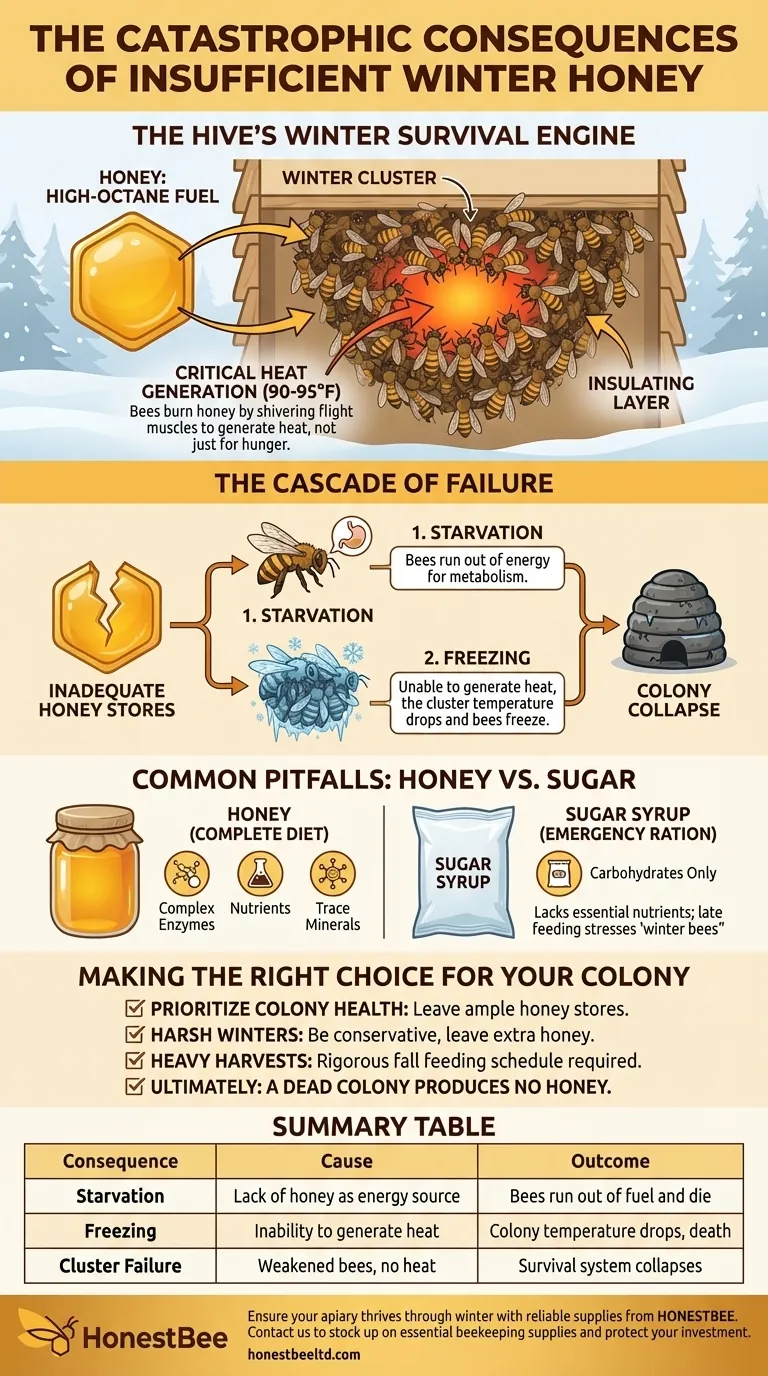In short, the consequences are catastrophic. If a honeybee colony is not left with enough honey for the winter, the bees will starve, be unable to generate heat, and the entire colony will freeze to death. This outcome is a direct result of disrupting their natural survival strategy.
The core issue is physics, not just hunger. Honey is the high-energy fuel bees burn by shivering their flight muscles to generate the heat necessary to keep the winter cluster alive. Without sufficient fuel, the colony's central heating system fails, leading to its inevitable collapse.

The Hive's Winter Survival Engine
To understand the severity of removing too much honey, you must first understand how a colony survives the cold. It's a remarkable feat of thermal regulation.
Honey as High-Octane Fuel
Honey is not just food; it is a dense, high-efficiency energy source. Its simple sugars are rapidly metabolized by the bees to power their bodies. This energy is the sole fuel source for the colony's winter survival.
The Winter Cluster
As outside temperatures drop, bees form a tight ball known as a winter cluster. The bees on the outer layer insulate the bees on the inside, which actively generate heat.
Generating Critical Heat
Bees in the cluster's core create warmth by vibrating their powerful wing muscles without moving their wings. This "shivering" consumes enormous amounts of energy and can keep the center of the cluster at a stable 90-95°F (32-35°C), even when it's freezing outside.
The Cascade of Failure When Honey Runs Low
When honey stores are inadequate, the colony's survival system breaks down in a predictable and fatal sequence.
The First Consequence: Starvation
This is the most direct outcome. Bees must eat continuously to fuel their high metabolism. Without access to honey stores, they simply run out of energy and die from starvation.
The Second Consequence: Freezing
Starvation and freezing are deeply linked. As individual bees weaken and starve, they can no longer generate heat effectively. The cluster's temperature begins to drop, its size shrinks, and its ability to keep itself warm diminishes until it can no longer combat the ambient cold. The remaining bees freeze.
Common Pitfalls and Misconceptions
While replacing honey with sugar is a common practice, it is not a perfect solution and comes with its own set of challenges. It should be seen as a necessary supplement, not an ideal replacement.
Sugar is Not Honey
Sugar syrup or fondant provides the necessary carbohydrates for energy but lacks the complex enzymes, nutrients, and trace minerals found in honey. It is an emergency ration, not a complete diet.
The Stress of Late Feeding
Feeding bees sugar syrup in the late fall forces them to expend significant energy to process and store it. This work can be stressful for the "winter bees" whose bodies are meant to conserve energy for surviving the long cold months.
Winter Feeding is an Emergency Intervention
Providing supplemental food like sugar cakes or fondant in the middle of winter is a last-ditch effort to prevent starvation. Opening the hive to do this breaks the colony's propolis seal and introduces cold, stressful air, risking the very bees you're trying to save.
Making the Right Choice for Your Colony
Your approach to the honey harvest directly determines your colony's chances of survival. A responsible beekeeper acts as a steward, not just a harvester.
- If your primary focus is colony health and sustainability: Prioritize leaving ample honey stores for the bees, only harvesting what is truly surplus.
- If you are in a region with long, harsh winters: Be conservative and leave more honey than recommended, as a harsh winter can quickly deplete stores.
- If you must harvest heavily for any reason: You must commit to a rigorous fall feeding schedule, ensuring the colony has time to convert sugar syrup into stored "syrup honey" well before cold weather sets in.
Ultimately, a dead colony produces no honey, so ensuring their winter survival is the most critical investment you can make.
Summary Table:
| Consequence | Cause | Outcome |
|---|---|---|
| Starvation | Lack of honey as energy source | Bees run out of fuel and die |
| Freezing | Inability to generate heat without honey | Colony temperature drops, leading to death |
| Cluster Failure | Weakened bees cannot maintain the winter cluster | Survival system collapses |
Ensure your apiary thrives through winter with reliable supplies from HONESTBEE. We supply commercial apiaries and beekeeping equipment distributors with the wholesale-focused equipment and resources needed to support healthy, sustainable colonies. Don't risk colony collapse—contact us today to stock up on essential beekeeping supplies and protect your investment.
Visual Guide

Related Products
- HONESTBEE Entrance Bee Feeder Professional Hive Nutrition Solution for Beekeeping
- Classic Boardman Entrance Bee Feeder Hive Front Feeding Solution
- Professional Hive Front Entrance Bee Feeder
- Boardman Entrance Bee Feeder Durable Galvanized Steel and Wood Construction for Beekeeping
- In-Hive Dual Compartment Frame Bee Feeder for Targeted Colony Nutrition
People Also Ask
- What is the best feeder for bees? Choose the Right Feeder for Your Hive's Success
- What are the common types of honey bee feeders? Choose the Right Feeder for Your Hive
- What is an entrance feeder? A Guide to Its Simple Design and High Robbing Risk
- Are entrance feeders good for bees? Prioritize Hive Health Over Convenience
- What are the different types of honey bee feeders? Choose the Right Feeder for Your Hive



















